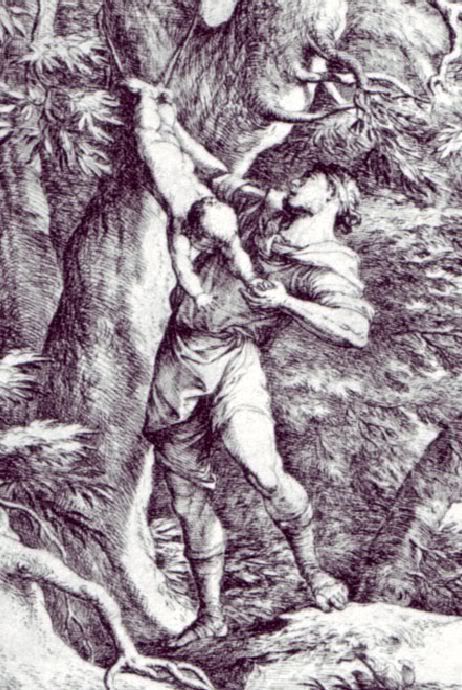Offspring Abandonment in the Ancient and Natural World


Oedipus Abandoned Remiz pendulinus nest
In the Greek tragedy Oedipus Rex the great kingdom of Thebes is condemned following a case of mistaken identity (and a little patricide). The sordid tale begins when the infant prince is abandoned by his parents after learning of a prophecy that his son will one day murder his father, marry his mother and assume the throne. His ankles pierced with a spike, young Oedipus is sent to be abandoned atop mount Cithaeron.
While this tale sets up a beautiful tragedy it also hints at a common reality in both the ancient and natural world. Before the scientific breakthroughs of contraception and abortion such abandonment was commonplace throughout human history. As John Boswell discusses in The American Historical Review:
“Abandonment of children provided, in fact, the primary means that ancient and medieval families had for regulating familial size and shape.” (Boswell 1984:12)
While it was usually the poor who abandoned their infants, in later centuries, this abandonment took on a more obvious economic tinge. Writing in her memoir Invent Radium or I’ll Pull Your Hair, Doris Drucker, describes the Christian village she grew up in at the turn of the 20th century:
Girls who had gotten themselves “into trouble” in the village became surrogate breast-feeders for women who could not or did not want to breast-feed their own newborns. Shortly after the girl had given birth, either she or her family gave the new baby away to an “Angelmaker,” a woman who starved the little children in her care to death, and the young mother was hired out as a wet nurse.
While Christian morality has sometimes had an unfortunate history of being neither Christ-like nor moral, the tragic strategy of child abandonment finds its parallel in all cultures and times. While such strategies are chosen for a variety of reasons, scientists are now beginning to understand in what circumstances such acts are most likely to occur.
A new report in the Journal of Evolutionary Biology shows how the tendency of parents to abandon their offspring can be understood using the sometimes-harsh logic of natural selection. It seems the penduline tit (Remiz pendulinus), a species native to Hungary, will frequently abandon up to one-third of their eggs if they can gain greater reproductive success elsewhere. As reviewed in Science Daily:
In an intensive battle of the sexes, male penduline tits often flee the nest before egg-laying is complete, whilst females sometimes hide their eggs from the males so she can leave before he notices how many eggs have been laid. When this happens, males left caring for the eggs frequently flee the nest.
As the currency of natural selection, any trait that increases reproductive success will perpetuate and thrive. While it seems counter-intuitive that abandoning a third of their eggs could result in a larger number of chicks, the birds unconsciously interpret their environment to determine if it’s more cost effective to raise their current brood or to move on and try again under better circumstances. This involves shifting strategies based on the perceived help, or lack thereof, of the bird’s partner.
Humans operate in the same fashion and interpret their environmental cues in order to determine if their present child is evolutionarily viable. As biologist David Sloan Wilson writes in his book Evolution for Everyone:
The three major adaptive contexts of infanticide [are] lack of resources, poor offspring quality, and uncertain paternity.
The first two contexts are relatively straight forward. If the parents are unable to raise their child given their poverty, or if their existing children won’t be able to survive with the extra mouth to feed, the tragic decision becomes understandable. Likewise is the decision if the child is sickly and is unlikely to live. The third context, uncertain paternity, has an amusing consequence with which I’ll end this discussion.
The evidence for an increased rate of neglect, child abuse and infanticide by step-fathers, up to one hundred times more likely than among biological fathers, is by now well established (this doesn’t mean, of course, that all step-fathers behave this way). This is an unfortunate legacy of our evolutionary history as, in many primate species, immigrant males that push out the previous alpha male opt to kill the existing infants rather than use up resources on offspring that aren’t his.
This heightened risk has also been found when fathers suspect the child might not be theirs. Since males can never be 100% certain that they are the infant’s father, families have developed a tactic to reassure new dads. Martin Daly and Margo Wilson from McMaster University, Ontario documented in the journal Ethology and Sociobiology that the family members of couples with newborns, especially the maternal family, are far more likely to insist that newborns resemble the father.
Quite obviously, newborns don’t look like anyone. Their heads are contorted from being squeezed out the birth canal and won’t take on familial resemblance for several months. Families are biased in favor of paternal resemblance due to the risk of neglect or abandonment should the father doubt paternity. Considering that 26 to 70 percent of women in Western countries cheat on their spouses (about the same for men), it would seem that new fathers have a great deal they need to be reassured about.
Oedipus was rescued from a fate all too common throughout human history only to find that his survival cost the lives of his parents. Such is the reality of the natural world at times (the folly of the gods as Sophocles might say) and is the source of Robert Trivers' Parent-Offspring Conflict Theory. Parents are sometimes forced to make difficult choices given existing environmental conditions in order to enhance their reproductive success.
By understanding the evolutionary history of offspring abandonment or abuse we can better predict the environments where this is likely to occur and offer alternatives. This evolutionary legacy highlights how we need to ensure that women around the world have the legal right to terminate their pregnancies in a safe and humane fashion if they need to (an option not widely available even in the United States). The penduline tit reminds us how natural selection can find harsh solutions to the difficult questions of life and death. Our policies should be informed by this history and offer practical solutions to often desperate circumstances.
References
Boswell, J.E. (1984). Expositio and Oblatio: The Abandonment of Children and the Ancient and Medieval Family. The American Historical Review (89)1:10-33.
Daly, M. & Wilson, M.I. (1982). Whom are newborn babies said to resemble? Ethology and Sociobiology 3:69-78.
Szentirmai, I., Szekely, T., Komdeur, J. (2007). Sexual conflict over care: antagonistic effects of clutch desertion on reproductive success of male and female penduline tits. Journal of Evolutionary Biology (OnlineEarly Articles - July 2007)


















2 comments:
Very interesting article.
"Quite obviously, newborns don’t look like anyone. Their heads are contorted from being squeezed out the birth canal and won’t take on familial resemblance for several months."
There are exceptions when especially obvious facial features are passed along. ;-) My first daughter (now 4) resembles many in my family, but she actually had a strong family resemblance to me (I'm the mom) in utero. Seriously. I've got sticky-out ears (or did, until otoplasty), and so does she. We spotted her little radar dishes on ultrasound. :-P They run in my father's side of the family.
She was born by emergency c-section, while I was under general anesthesia. It was an odd feeling to have this strange baby placed in my arms, wondering how I could even know if they'd gotten the wrong baby. Then I saw her ears, and was content in the knowledge that indeed, this was my child. :-P
quite interesting.
but how does evolution explain adoption in human beings.
my four year adopted daughter is a real angel and i cant for the life of me believe she was abandoned as an infant.
geetha
Post a Comment